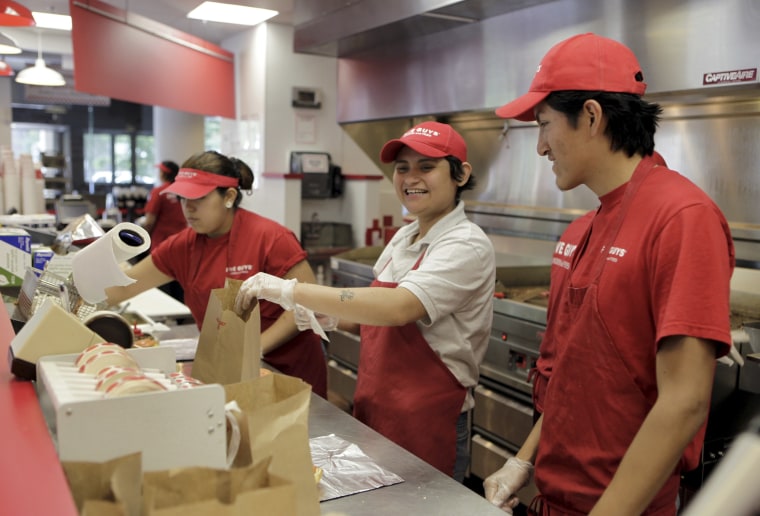The weak U.S. economy is no match for fast-growing Five Guys Burgers and Fries, where the standard hamburger has two patties and french fries are served in a cup with an extra scoop on the side for good measure.
While most U.S. restaurants fight for every dollar, a new crop of indulgent burger chains have bucked the trend by recasting the American food standard with higher-quality ingredients and quirky toppings like fried eggs or pineapple.
The upstart burger joints run the gamut from Five Guys, a 600-unit chain known for its simple menu, fresh ingredients and generous portions, to Bobby's Burger Palace, Chef Bobby Flay's small but swanky chain.
They also include Denver-based Smashburger and The Counter from Los Angeles and range from retro-cool to modern.
"There's an element of fun to burgers," said Scott Hume, editor of the industry blog BurgerBusiness.com, who added that the enduring popularity of the "infinitely changeable" hamburger also springs from its broad appeal.
"Burgers, unlike any other niche in the restaurant business, span generations and span prices," he said.
The newest burger joints understand that while "adults like to be in control, teenagers just like to eat."
Last year, the hamburger and sandwich category was the only one to post growth in the number of servings sold at full-service and quick-service restaurants, according to NPD Group, a market research company.
And new operators plan to keep building units, even as beef prices start creeping upward.
Burgers are big business
"Better burgers are back," said David Prokupek, chairman and chief executive at Smashburger, which offers beer and wine and customizes its menus by state. For example, its Colorado burger is topped with two kinds of cheese, grilled green chilies and served on a chipotle bun.
Some new chains offer sweet potato fries as an option. Smashburger goes a bit further with "veggie frites" — fried asparagus, carrots and green beans — and fried pickles.
The chain had 45 stores at the end of last year and plans to have roughly 200 by the end of 2011, Prokupek said.
That is rapid growth at a time when most major restaurants have reeled in expansion plans, but it pales in comparison with Five Guys, which has 1,500 units in various stages of development around the country and plans to end this year with around 800 in operation.
Sales grew 70 percent to $499 million last year.
In the category of restaurants with annual sales of more than $200 million annually, Five Guys was the fastest-growing in 2009, according to consulting firm Technomic.
Five Guys gets high scores from Zagat, which rates restaurants based on diner surveys. U.S. President Barack Obama and first lady Michelle Obama — who has made fighting childhood obesity her signature issue — each have been spotted in the chain's red-and-white tiled restaurants.
The company bakes its own buns, makes its hamburger patties by hand from fresh ground beef and cuts its french fries from U.S. Northwest potatoes — sparking comparisons to California's popular, family-owned In-N-Out Burger chain.
"We know how to cook hamburgers and french fries. Why recreate the wheel?" said Chad Murrell, who oversees operations and training at Five Guys, which has no plans to expand the menu and takes no issue with In-N-Out references.
"We just love the way they run their company," said Murrell, who is the third of founder Jerry Murrell's five sons, for whom the chain is named.
Southern California, home of In-N-Out and the McDonald's 15-cent hamburger restaurant that inspired the now-global brand, is also the birthplace of the Counter.
But Jeff Weinstein, founder of that more upscale, 24-restaurant chain, says many of the similarities end there.
"The whole 1950s, 1960s thing seemed a little tired," said Weinstein. "Everybody wants to personalize everything from Facebook pages to ringtones to the burger."
The Counter chain has diners fill out order forms on clip boards and says it offers more than 312,000 topping combinations for its hormone-free and antibiotic-free burgers. Its restaurants serve alcohol and have a hipster, lounge feel in the evening.
A sure bet?
When it comes to updating a menu, "there is no more sure bet than a new burger," said to BurgerBusiness.com's Hume.
And that is just what many of the world's biggest operators have done.
Fast-food giant McDonald's added larger and higher-priced Angus burgers, while high-end steakhouses such as Mortons Restaurant Group came a bit down to earth and emphasized their premium burgers. Elsewhere, the Cheesecake Factory refreshed its menu with a collection of themed "Glamburgers."
The recipe works for many chains, but it is not fail-proof.
The parent company of Fuddruckers, a burger chain founded in the 1980s, filed for bankruptcy protection in April.
Rising food costs and burger fatigue also are risks. Just this month, Red Robin Gourmet Burgers said beef and produce costs could be higher than expected in the coming quarters.
While the craze shows no signs of cooling yet, Technomic Executive Vice President Bob Goldin said: "At some point we'll get sick of eating all those burgers and it will die down."
